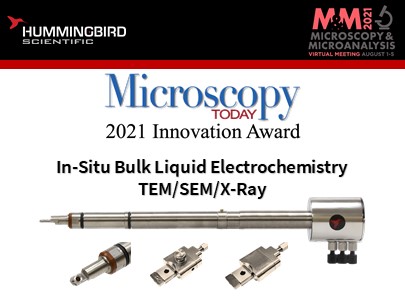
Hummingbird Scientific is one of the 10 recipients of the 2021 Microscopy Today Innovation Award. Each year the award is presented to the most innovative and microscopy-related products and methods. Hummingbird received the award for the multimodel in situ bulk liquid-electrochemistry microscopy platform that enables in situ high-magnification microscopy and spectroscopy across TEM, SEM, and X-ray microscopy of liquid-electrochemical processes that match the behavior of bulk electrochemistry. It achieves this while maintaining all the features of traditional in situ liquid cell microscopy systems: nanometer-scale membranes that enclose a thin layer of liquid environment, control of liquid pressure and flow, temperature control from RT to the liquid boiling point, electrical biasing, and energy-dispersive X-ray spectrometry (EDS) for elemental analysis.
The present innovation involves miniaturizing standard bulk reference and counter electrodes (RE and CE) and placing them in line with the liquid flow to the specimen. The working electrode (WE) is located on the chip inside the liquid cell for imaging of the electrochemical process of interest. This configuration overcomes issues associated with using quasi-REs and quasi-CEs on-chip, which in previous studies have led to unstable rest potentials and a lack of distinct data peaks. Thus, previous results have been challenging (if not impossible) to relate to the electrochemical process they are supposed to represent. We have overcome these issues with a miniaturized three-electrode bulk liquid-electrochemical cell that is small enough to fit inside the small specimen space in high-magnification TEM, SEM, and X-ray microscopes.
Traditional in situ high-magnification liquid-cell microscopy systems do not incorporate realistic bulk electrodes and reference electrodes. Previous attempts at high magnification in situ liquid-electrochemical cells employ unreliable on-chip quasi- REs (QREs) inside the liquid cell. Because of the small volume of liquid in the cell, the QRE, which sits in the reagent electrolyte, only provides a quasi-reference potential. As the reagent solution changes during the reaction, so does the reference potential (hence quasi-reference electrode). This makes the chemistry observed unrepresentative of chemistry performed on the beaker scale. The present innovation overcomes this lack of relevance to reaction conditions. Technologies that could benefit from this liquid-electrochemical system include electrochemical processes related to energy storage devices such as batteries, supercapacitors, and fuel cells. It could also have an impact on nanoscale synthesis for next-generation electronic devices. Thus, the system could aid in the development of lower-cost, longer-lasting, faster-operating, and environmentally friendlier electrical and energy-storage devices.
Learn more about the in-situ bulk electrochemistry products:
In-situ TEM bulk electrochemistry holder
In-situ SEM bulk electrochemistry holder
In-situ X-ray bulk electrochemistry holder
View All News

